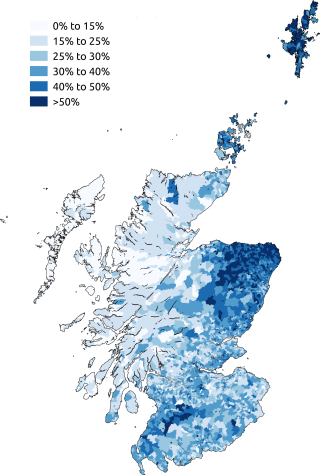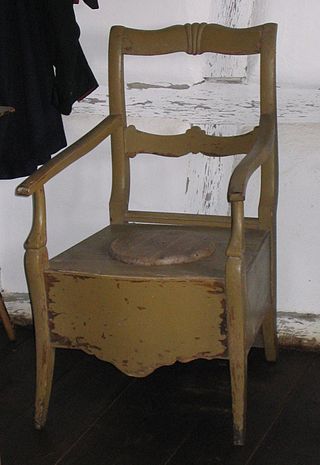
Ossian is the narrator and purported author of a cycle of epic poems published by the Scottish poet James Macpherson, originally as Fingal (1761) and Temora (1763), and later combined under the title The Poems of Ossian. Macpherson claimed to have collected word-of-mouth material in Scottish Gaelic, said to be from ancient sources, and that the work was his translation of that material. Ossian is based on Oisín, son of Fionn mac Cumhaill, a legendary bard in Irish mythology. Contemporary critics were divided in their view of the work's authenticity, but the current consensus is that Macpherson largely composed the poems himself, drawing in part on traditional Gaelic poetry he had collected.

Scottish Gaelic, also known as Scots Gaelic or simply Gaelic, is a Goidelic language native to the Gaels of Scotland. As a Goidelic language, Scottish Gaelic, as well as both Irish and Manx, developed out of Old Irish. It became a distinct spoken language sometime in the 13th century in the Middle Irish period, although a common literary language was shared by the Gaels of both Ireland and Scotland until well into the 17th century. Most of modern Scotland was once Gaelic-speaking, as evidenced especially by Gaelic-language place names.

Scots is a language variety descended from Early Middle English in the West Germanic language family. Most commonly spoken in the Scottish Lowlands, the Northern Isles of Scotland, and northern Ulster in Ireland, it is sometimes called: Lowland Scots, to distinguish it from Scottish Gaelic, the Celtic language that was historically restricted to most of the Scottish Highlands, the Hebrides, and Galloway after the sixteenth century; or Broad Scots, to distinguish it from Scottish Standard English. Modern Scots is a sister language of Modern English, as the two diverged from the same medieval form of English.

Scottish literature is literature written in Scotland or by Scottish writers. It includes works in English, Scottish Gaelic, Scots, Brythonic, French, Latin, Norn or other languages written within the modern boundaries of Scotland.

A scold's bridle, sometimes called a witch's bridle, a gossip's bridle, a brank's bridle, or simply branks, was an instrument of punishment, as a form of public humiliation. It was an iron muzzle in an iron framework that enclosed the head. A bridle-bit, about 5 cm × 2.5 cm in size, was slid into the mouth and pressed down on top of the tongue, often with a spike on the tongue, as a compress. It functioned to silence the wearer from speaking entirely, to prevent the women from nagging. The scold's bridle was used on women. This prevented speaking and resulted in many unpleasant side effects for the wearer, including excessive salivation and fatigue in the mouth. For extra humiliation, a bell could also be attached to draw in crowds. The wearer was then led around town by a leash.

Janet "Jenny" Geddes was a Scottish market-trader in Edinburgh who is alleged to have thrown a stool at the head of the minister in St Giles' Cathedral in objection to the first public use of the Church of Scotland's revised version of the Book of Common Prayer, the 1637 Scottish Prayer Book. The act is reputed to have sparked the riot that led to the Wars of the Three Kingdoms, which included the English Civil War.

The Kingdom of Alba was the Kingdom of Scotland between the deaths of Donald II in 900 and of Alexander III in 1286. The latter's death led indirectly to an invasion of Scotland by Edward I of England in 1296 and the First War of Scottish Independence.

The Bishop of St. Andrews was the ecclesiastical head of the Diocese of St Andrews in the Catholic Church and then, from 14 August 1472, as Archbishop of St Andrews, the Archdiocese of St Andrews.

The High Middle Ages of Scotland encompass Scotland in the era between the death of Domnall II in 900 AD and the death of King Alexander III in 1286, which was an indirect cause of the Wars of Scottish Independence.
A cuttie-stool, or cutty-stool, was a type of three-legged chair used in Scotland. It was a short stool, often having a round seat on the top, but the word also designates a larger piece of furniture associated with public penance in church.

The languages of Scotland belong predominantly to the Germanic and Celtic language families. The main language now spoken in Scotland is English, while Scots and Scottish Gaelic are minority languages. The dialect of English spoken in Scotland is referred to as Scottish English.

Scotland was divided into a series of kingdoms in the Early Middle Ages, i.e. between the end of Roman authority in southern and central Britain from around 400 AD and the rise of the kingdom of Alba in 900 AD. Of these, the four most important to emerge were the Picts, the Gaels of Dál Riata, the Britons of Alt Clut, and the Anglian kingdom of Bernicia. After the arrival of the Vikings in the late 8th century, Scandinavian rulers and colonies were established on the islands and along parts of the coasts. In the 9th century, the House of Alpin combined the lands of the Scots and Picts to form a single kingdom which constituted the basis of the Kingdom of Scotland.
In English law and the canon law of the Church of England, a rebuke is a censure on a member of the clergy. It is the least severe censure available against clergy of the Church of England, less severe than a monition. A rebuke can be given in person by a bishop or by an ecclesiastical court.

A close stool was an early type of portable toilet, made in the shape of a cabinet or box at sitting height with an opening in the top. The external structure contained a pewter or earthenware chamberpot to receive the user's excrement and urine when they sat on it; this was normally covered (closed) by a folding lid. "Stool" has two relevant meanings: as a type of seat and as human feces. Close stools were used from the Middle Ages until the introduction of the indoor flush toilet.
Buttock mail or buttock hire was the colloquial term for a Scottish Poor Law tax which was introduced in 1595. Enforced by the ecclesiastical courts who had responsibility for the moral behaviour of the laity, buttock mail was levied as a fine for sexual intercourse out of wedlock.
Scottish Gaelic literature refers to literary works composed in the Scottish Gaelic language, which is, like Irish and Manx, a member of the Goidelic branch of Celtic languages. Gaelic literature was also composed in Gàidhealtachd communities throughout the global Scottish diaspora where the language has been and is still spoken.

Literature in early modern Scotland is literature written in Scotland or by Scottish writers between the Renaissance in the early sixteenth century and the beginnings of the Enlightenment and Industrial Revolution in mid-eighteenth century. By the beginning of this era Gaelic had been in geographical decline for three centuries and had begun to be a second-class language, confined to the Highlands and Islands, but the traditions of Bard poetry in the Classical Gaelic literary language continued to survive. Middle Scots became the language of both the nobility and the majority population. The establishment of a printing press in 1507 made it easier to disseminate Scottish literature and was probably aimed at bolstering Scottish national identity.

Poetry of Scotland includes all forms of verse written in Brythonic, Latin, Scottish Gaelic, Scots, French, English and Esperanto and any language in which poetry has been written within the boundaries of modern Scotland, or by Scottish people.

Scottish literature in the eighteenth century is literature written in Scotland or by Scottish writers in the eighteenth century. It includes literature written in English, Scottish Gaelic and Scots, in forms including poetry, drama and novels. After the Union in 1707 Scottish literature developed a distinct national identity. Allan Ramsay led a "vernacular revival", the trend for pastoral poetry and developed the Habbie stanza. He was part of a community of poets working in Scots and English who included William Hamilton of Gilbertfield, Robert Crawford, Alexander Ross, William Hamilton of Bangour, Alison Rutherford Cockburn, and James Thomson. The eighteenth century was also a period of innovation in Gaelic vernacular poetry. Major figures included Rob Donn Mackay, Donnchadh Bàn Mac an t-Saoir, Uillean Ross and Alasdair mac Mhaighstir Alasdair, who helped inspire a new form of nature poetry. James Macpherson was the first Scottish poet to gain an international reputation, claiming to have found poetry written by Ossian. Robert Burns is widely regarded as the national poet.
Alexander Nicolson (1827–1893) was a Scottish lawyer and man of letters, known as a Gaelic scholar and sheriff-substitute of Kirkcudbright and Greenock, and as a pioneer of mountain climbing in Scotland.















